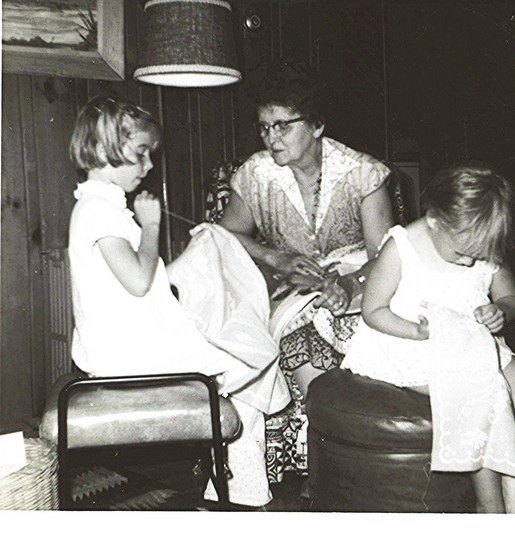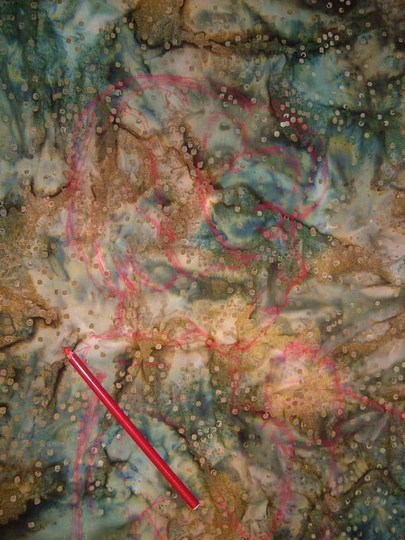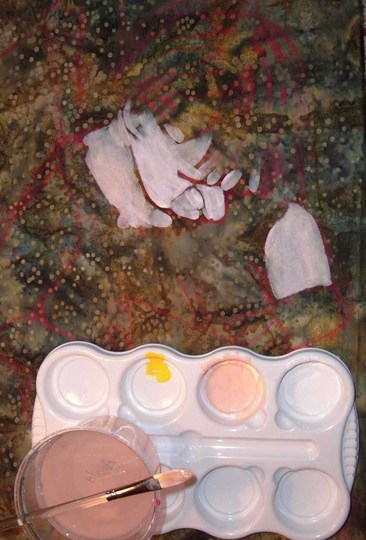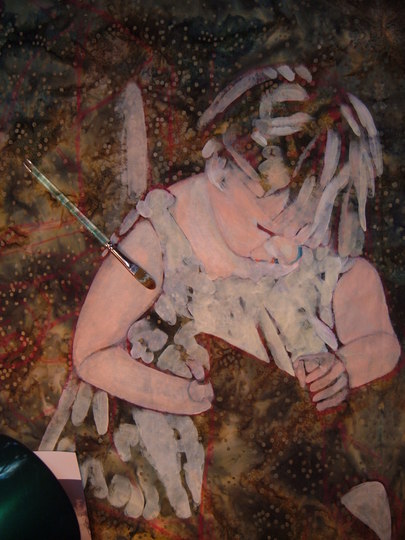
Alex practicing her sewing skills. Alex, stubborn as always, has her back to Grandmother.
When Alex gave her speech and slide show at The Silver Star Awards event at the Houston Quilt Show last fall, and I saw the childhood images of her with her sister, Sidney, and their Grandmother up on the screen, a warm fuzzy feeling came over me. Shortly afterwards, Alex sent me some amazing black-and-white photographs. I love working with black-and-white photos. I like to see if I can come up with colors that duplicate or closely match the originals.
Currently, I am in a wonderful portrait mode with this quilt. My Mom ( Barbara) and I looked for just the right fabrics, and we found something that spoke of warmth and of home: one-and-a-half meters of batik fabric in earth tones from The Satin Moon Quilt Shop in Victoria, B.C., was her Christmas gift to me.
After washing and pressing the fabric, I begin to draw. Because the fabric is a dark-colored cotton, I use a hot-pink pastel pencil to see my lines. If you use this type of pencil, and add a line that you decide you don't want, you can remove it easily by rubbing lightly with a cloth or paper towel. By the time you are into the sewing stage, any marks left on the fabric will be very faint, if visible at all.
Once I am happy with the drawing, I leave it alone for a few days and look at what I have done. Is it OK? Yes! I am ready to paint.

Pastel outline foundation. Photo By Gail Thom
I begin painting from the edge of the fabric that is now 46" x 59". Since I don't want to rub off the pastel pencil lines or smudge as I am painting; I start with Alex, who is at the fabric's edge. I like to paint foundation lines first, so that later I will know where to put in my brush strokes (i.e., for faces, hands, feet). I do not work all the way around the quilt. I turn it upside down, sideways, and every-which-way to get to the heart of the matter. A painted face might look fine, but if I can turn the image and look at it from a different angle, I might discover something else altogether.
Here are the first strokes of paint: yellow, a little pink, and mostly white. I am using Angel Paints, Canadian paints made in Vancouver, B.C. I use the drawing marks as a guide.

Painted features begin to appear. Photo by Gail Thomas
I have been painting since I was seven, and working with watercolors came naturally to me. (It's kind of spooky at times!) In 2007, I found non-toxic Canadian fabric paint on the Internet, in Vancouver, B.C., a six-hour drive from my home. Jackie Haliburton created and founded Angel Paint 20 years ago. (Yikes! I'm just a little sl...oow....!) When I discovered them, the door to painting on fabric opened wide.These paints have a smooth feeling and mix beautifully. You can add a lot of water to the colors, and yet they do not bleed as much as some of the other brands I have tried. I am able use a watercolor wash technique--that is, use more water than pigment, allow to dry, and apply again--to build up the depth and dimension. I am able to paint on fabric the way I want.
I love that I can make the piece "move" with these paints. Let me explain: The translucent layers allow me to see all the other layers underneath, giving the illusion of many veils overlapping. The images, especially clothing, take on a movement. In some areas, the body underneath is visible, or shapes and color appear from behind and around the clothes themselves. On faces, the multiple layerings pick up color. If, for example, a small child is asleep on a pink or red pillow, she will take on more of the pink and red colors as well as the color that makes up her presence or essence. Angel Paints allow me to build up layers so that the viewer can see the work come to life...to mold the images or objects as he or she envisions them.
As I continue to work, I keep adding layers and painting in new areas. I am still using yellow, a little pink, as well as white. For Alex's dress, I add more white to my painting wash. I want to paint all the areas that require those colors. To me color is everything, even black and white, so when I say all those areas that have those colors, those are the colors I see.

Adding more layers of paint to the subject. Photo by Gail Thomas
For this art quilt, I will be adding machine threadwork, stenciling, and possibly some handwork. I love handwork that features different stitches. This helps to bring out the down-home feeling.
For this art quilt, I will be adding machine threadwork, stenciling, and possibly some handwork. I love handwork that features different stitches. This helps to bring out the down-home feeling.
For this art quilt, I will be adding machine threadwork, stenciling, and possibly some handwork. I love handwork that features different stitches. This helps to bring out the down-home feeling.
Gail Thomas




.jpg)


